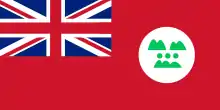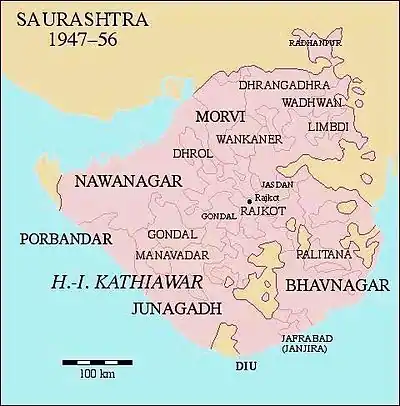Junagadh State
Junagarh or Junagadh was a princely state in Gujarat[1] ruled by the Muslim Babi dynasty in British India, until its annexation by the Union of India in 1948.
| Junagadh State | |||||||||
|---|---|---|---|---|---|---|---|---|---|
| Princely State of British India | |||||||||
| 1730–1948 | |||||||||
 Flag
 Coat of arms
| |||||||||
 Location of Junagarh in Saurashtra, among all princely states shown in pink | |||||||||
| Area | |||||||||
• 1921 | 8,643 km2 (3,337 sq mi) | ||||||||
| Population | |||||||||
• 1921 | 465,493 | ||||||||
| History | |||||||||
• founded | 1730 | ||||||||
| 1948 | |||||||||
| |||||||||
| Today part of | Gujarat, India | ||||||||

History
Muhammad Sher Khan Babai was the founder of the Babi dynasty of Junagarh in 1654. His descendants, the Babi Nawabs of Junagarh, conquered large territories in southern Saurashtra.
However, during the collapse of the Mughal Empire, the Babis became involved in a struggle with the Gaekwad dynasty of the Maratha Empire over control of Gujarat during the reign of the local Mohammad Mahabat Khanji I. Mohammad Khan Bahadur Khanji I declared independence from the Mughal governor of Gujarat subah, and founded the state of Junagarh in 1730. This allowed the Babi to retain sovereignty of Junagarh and other princely states. During the reign of his heir Junagarh was a tributary to the Maratha Empire,[2] until it came under British suzerainty in 1807 under Mohammad Hamid Khanji I,[1] following the Second Anglo-Maratha War.
In 1807, Junagarh became a British protectorate and the East India Company took control of the state. By 1818, the Saurashtra area, along with other princely states of Kathiawar, were separately administrated under the Kathiawar Agency by British India.
In 1947, upon the independence and partition of India, the last Babi dynasty ruler of the state, Muhammad Mahabat Khanji III, decided to merge Junagarh into the newly formed Pakistan.
Rulers
The Nawabs of Junagarh belonged to Pathan Babi or Babai (Pashtun tribe). They were granted a 13 gun salute by the British authorities:[3]
- 1730–1758 : Mohammad Bahadur Khanji I or Mohammad Sher Khan Babai[4]
- 1758–1774: Mohammad Mahabat Khanji I
- 1774–1811: Mohammad Hamid Khanji I
- 1811–1840: Mohammad Bahadur Khanji II
- 1840–1851: Mohammad Hamid Khanji II
- 1851–1882: Mohammad Mahabat Khanji II
- 1882–1892: Mohammad Bahadur Khanji III
- 1892–1911: Mohammad Rasul Khanji
- 1911–1948: Mohammad Mahabat Khanji III (last ruler before the integration of Junagarh to India)
 Junagarh Nawabs and state officials, 19th century
Junagarh Nawabs and state officials, 19th century Mohammad Mahabat Khanji II, the Nawab of Junagarh, with young, Mohammad Bahadur Khanji III, 1870s
Mohammad Mahabat Khanji II, the Nawab of Junagarh, with young, Mohammad Bahadur Khanji III, 1870s Bahadur Khanji II (r. 1882–1892), Nawab of Junagarh, and state officials, 1880s
Bahadur Khanji II (r. 1882–1892), Nawab of Junagarh, and state officials, 1880s Mohammad Rasul Khanji, Nawab of Junagarh, Bahaduddinbhai Hasainbhai, Wazier, Junagarh, 1890s
Mohammad Rasul Khanji, Nawab of Junagarh, Bahaduddinbhai Hasainbhai, Wazier, Junagarh, 1890s
Rebellion
Koli rebellion in Junagarh raised by Mansa Khant during time of Nawab Sher Khan the first ruler of Junagarh. He was against Mughal Rule, Made Uparkot Fort his centre. He made a series of raids in surrounding villages and cities. Nawab was unsuccessful to control the rebellion. Mansa Khant occupied the Uparkot for thirteen months and make numerous raids mostly in countryside. Nawab started compaign against Khant. Nawab was assisted by king of Gondal State Thakur Sahib Haloji Jadeja and Arab Jamadar Sheikh Abdullah Zubeidi. The combined forces defeated the Khant and captured Uparkot and burnt down the rebellion.[5][6]
Integration into India
In 1947, Shah Nawaz Bhutto joined the council of ministers of Nawab Muhammad Mahabat Khan III, and in May became his dewan or prime minister.
With the independence of India in 1947, the princely states were left by the British to decide whether to accede to one of the newly independent states of India or Pakistan or to remain outside them. The Constitutional Advisor to the Nawab, Nabi Baksh, indicated to Lord Mountbatten that he was recommending that Junagarh should join India. However, upon the advice of Dewan Bhutto, on 15 August 1947, the Nawab announced that Junagarh had acceded to Pakistan. On 13 September, the Government of Pakistan accepted the accession.[7]
India sent its military into Junagarh while Nawab of Junagarh was in Pakistan and capture the state of junagarh overthrowing Nawab and the rights of princely states. The integration of Junagarh into India led the[8] Nawab Muhammad Mahabat Khan III of Junagarh (erstwhile Babi nawab dynasty of Junagarh) left to live in Sindh, Pakistan.[9]
See also
References
- Chisholm, Hugh, ed. (1911). . Encyclopædia Britannica. 15 (11th ed.). Cambridge University Press. pp. 554–555.
- Georg Pfeffer; Deepak Kumar Behera (1997), Contemporary Society: Concept of tribal society, p. 198, ISBN 9788170229834
- Soszynski, Henry. "JUNAGADH".
- Nawabs of Junagarh Archived 9 February 2012 at the Wayback Machine British Library.
- Williams, Raymond Brady; Trivedi, Yogi (12 May 2016). Swaminarayan Hinduism: Tradition, Adaptation, and Identity. Oxford University Press. ISBN 9780199089598.
- shodhganga.inflibnet.ac.in (PDF) http://shodhganga.inflibnet.ac.in/bitstream/10603/59303/8/08_chapter%20iv.pdf. Retrieved 1 January 2019. Missing or empty
|title=(help) - Menon, V. P. (1956). The Story of Integration of the Indian States (PDF). Orient Longman. pp. 85–87.
- Gandhi, Rajmohan (1991). Patel: A Life. India: Navajivan. p. 292.
- "Archived copy". Archived from the original on 25 February 2013. Retrieved 5 July 2016.CS1 maint: archived copy as title (link)
External links
| Wikimedia Commons has media related to Junagadh State. |